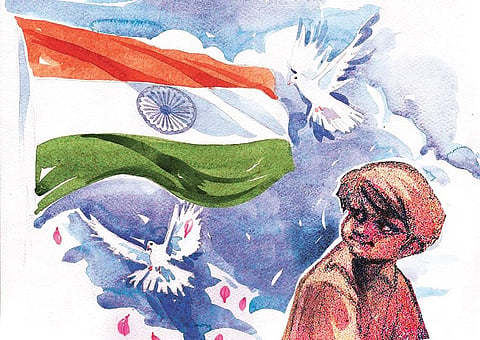

It is heartening to see Prime Minister Narendra Modi trying to make ‘Har Ghar Tiranga’ a movement with the avowed intention of deepening the citizens’ connection with the National Flag. It is quite a movement forward from the position taken by the ruling establishment’s forebearers. It is said that when asked to give their suggestions, they had produced a saffron triangular design like a temple flag. But the so-called movement is disquieting in a way.
Everywhere around the world, people feel proud to fly their flags, display them with pride and wave it with fervour. But in India, it is being mandated by the government instruction, however mild the persuasion. It is not limited to the spontaneous response of the citizenry, which has never been lukewarm, but never so widespread. People know from experience that the neighbourhood representatives will be watching and reporting back. They would fly it most probably only to avoid the trouble of being profiled.
It appears that there is a keenness to create a Guinness record. Given our population size, substantial compliance will result in a record of sorts. It is also an attempt to show that the country has become
a force to be reckoned with. What do the colours and the Dharma Chakra in the middle of the flag signify? The saffron band indicates strength and courage. Green stands for fertility, growth and auspiciousness of the land. The white belt with Ashoka Chakra indicates peace and truth.
This flag is torn from the soul of the people during the freedom struggle. When the ambient picture is in sync with the aspirations of the founding fathers and the people encapsulated in the flag, it works, otherwise, it doesn’t. Has the republic lived up to this aspiration? The answer is both yes and no. On many fronts, it is a work in progress and on several others, our action has veered away from the embedded vision.
When one-half of the population continues to be poor in different shades—when 13 per cent share of national income and wealth share of 6 per cent is contrasted with the top 10 per cent having 57 per cent of the income and 64 per cent of the wealth, it is a no-brainer to figure out whose republic it has become. When unemployment is so widespread and more than 30 per cent of the persons who have completed college remain unemployed and do not see any change in their future, the country cannot be strong, and wishing them to be courageous is asking for the moon.
With low growth, labour employment intensity, which a study of Azim Premji University puts at 1 per cent with 10 per cent growth, the question to be asked is whose growth has it been. The growth the country has seen has disproportionately gone to a smaller group without the gain of universalisation. The farmer agitation revealed the turmoil in the farm sector, which supports 45 per cent of the population. Even purchasing a moderately priced flag at `25 will need some amount of rejigging in expenditure involving trade-off for at least 30 per cent of the households which the government supports with free ration and admittedly are extremely vulnerable economically.
Lok Nayak Jayaprakash Narayan had presciently predicted that “although almost every religious community has its own brand of communalism, Hindu communalism can easily masquerade as Indian nationalism and denounce all opposition to it as being anti-national”. We have seen the genie of majoritarianism escape and is beginning to sunder the fabric of the nation.
No flag is large enough to cover these failures. Only a partly consolidated nation has started unravelling for the flag to have much real meaning. Waving a flag is hardly a metaphor for patriotism for
a country which has often failed its citizens for electoral politics and sliced at the citizens’ space. Credited to Liz Truss, “A Union Jack flag on the top of a beer bottle one sees because it sells.” It is one way of looking at the role of the flag bereft of its intrinsic meaning.
Haiti’s strongman François Duvalier had declared himself as the flag of Haiti and concluded that anyone who was his enemy was the enemy of the fatherland. But the national flag carries meaning much beyond the commercial and self-serving parameters like these. For that symbol to be meaningful, the reality behind will have to be in sync. More symbols will not change reality. After all the flag is not the territory, whether physical or conceptual.
Satya Mohanty
satya_mohanty@rediffmail.com
Former Secretary, Government of India